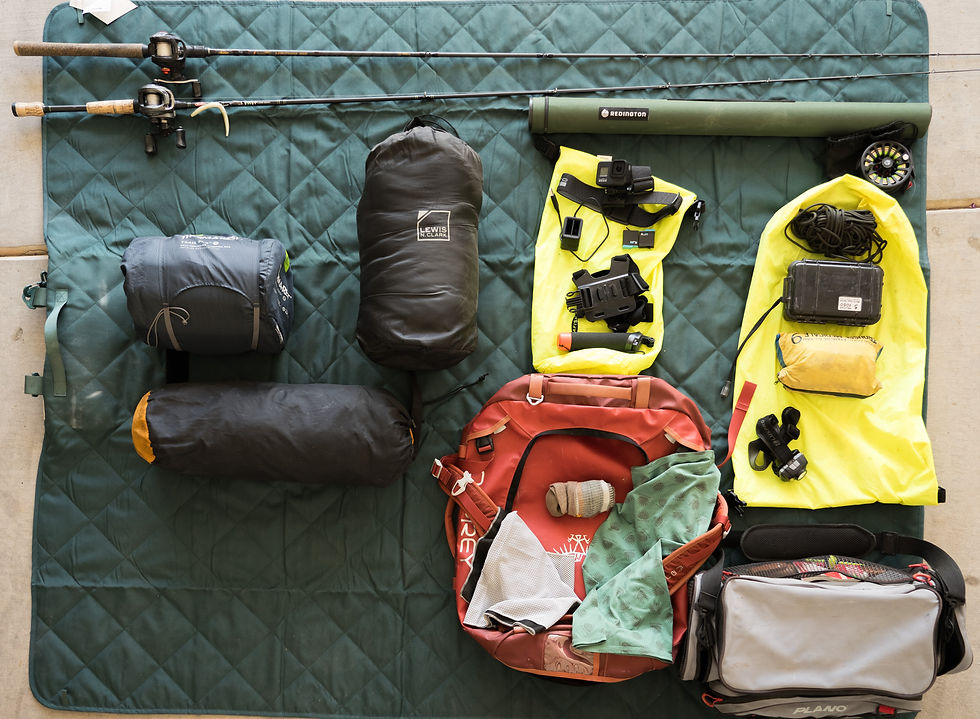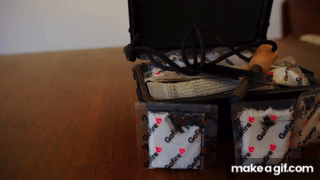Gear list for my remote camping trip to Lake Powell
- Follow the Fish

- Jul 19, 2024
- 4 min read
If you haven't seen it already, watch my Lake Powell fishing video where I go out and camp on the shores of Lake Powell and catch a ton of Smallmouth Bass in the process.
Once your done watching that, I want to share with you all my review of the gear I used and how each piece of equipment benefitted me during this last trip. Keep in mind, I had to pack light. I was going 50 miles upriver with three other people in a 19 foot boat. There wasn't a ton of room to go around, so everything I chose to bring had to be essential and have a purpose.

Other than clothes, this is all the gear I took with me. To break this down a bit ill go by category. First and most important, fishing, I brought two baitcaster rods (medium-heavy and medium-light), 8 wt Redington fly rod, and a 4-box tackle box.
During my recent fishing trip, I meticulously planned my gear selection to cater to the diverse fishing techniques I intended to employ. Understanding the importance of matching the right rod to the specific fishing method, I carefully chose different rods for finesse lures and heavier lures. For finesse lures, I opted for a light shorter rod that would provide me with the precision and sensitivity needed to detect subtle bites effectively. This choice proved invaluable as I managed to hook into some elusive fish that might have otherwise gone unnoticed.
On the other hand, I made sure to have a medium heavy rod at hand for casting heavier lures like jigs, especially when targeting fish at the bottom of the water column. This rod's strength and power allowed me to effortlessly launch my lures to the desired spots, increasing my chances of enticing the fish lurking below. Anticipating a potential topwater bite in the morning, I had my trusty fly rod ready to capitalize on any surface action.
For targeting morning topwater eats, I selected a firetiger colored MeeMaw from Blue Line Flies (see below; left), a pattern known for its effectiveness in mimicking natural prey and eliciting strikes from predatory fish. Blue Line makes a ton of effective streamer patterns that I like to use and emulate in flies that I tie. The MeeMaw is good at reaching deeper water in rivers and streams, but on this trip it was basically my "topwater" fly.
In the evenings, I shifted my focus to targeting largemouth bass in shallow coves near camp. I opted for a brownish orange woolly bugger (right) tied on a size 2 hook, a choice that proved to be a game-changer. This particular fly had already proven its worth by landing three largemouth bass, establishing itself as a successful pattern in my arsenal. The decision to use this specific color combination was from researching angler online communities. I had studied images of crawdads collected at Lake Powell with orange bellies, leading me to believe that this color scheme would effectively mimic the natural forage of the bass in that environment.
When it comes to my sleeping gear, I prefer to maintain a minimalist approach for convenience and ease of use. The essentials for a good night's sleep in the great outdoors include a reliable tent, a comfortable sleeping pad, and a warm sleeping bag. However, one item that I have found to greatly enhance my camping experience is the ultralight Sea to Summit pillow. This compact pillow not only provides excellent support for my head and neck but also adds a touch of comfort that can make a significant difference after a long day of fishing.
Miscellaneous gear that made it into my pack was a cooling towel, neck gaiter, paracord, med kit, headlamp, and my fire starter kit (GIF below).

These were my essentials. I knew I didn't have much space to take up in the boat, so after many lists and researching the best gear, this is what I came up with. This is the part where I tell you what I needed, forgot, and wish I had. To be honest, all I needed was more hooks and jigs. We were catching so many fish that our jig tails were getting thrashed after a couple fish caught.
During this trip, I had the opportunity to delve into the intricacies of fishing and truly understand the art behind it. It became evident to me that mastering a fishery is not an instant process but rather a gradual one that requires patience and observation. Despite the initial excitement of a thriving fishery, it took me a few days to unravel its nuances and complexities.
As I immersed myself in the experience, I realized that each fishery has its own unique characteristics and behaviors. It was not merely about casting a line and waiting for a bite; it was about deciphering how the fish responded to different movements and techniques. I found myself experimenting with various approaches, trying to decode the subtle cues that would lead to a successful catch.
Furthermore, the significance of color selection in fishing became apparent to me during this trip. I discovered that the choice of trailer color could significantly impact the fish's interest and willingness to bite. It was a fascinating process of trial and error, as I tested out different colors to see which ones elicited the most positive responses from the fish.
Ultimately, this trip taught me the value of persistence and adaptability in fishing. It reinforced the notion that true mastery of a fishery requires time, effort, and a willingness to learn from every cast. By the end of day three, I had gained a deeper understanding of the fishery and felt a sense of accomplishment in cracking its code.
I hope this helps you decide how to tackle your next fishing trip. And as a good rule of thumb, follow the fish.























Comments